Qifei Wang
Calibrated Multi-Preference Optimization for Aligning Diffusion Models
Feb 04, 2025Abstract:Aligning text-to-image (T2I) diffusion models with preference optimization is valuable for human-annotated datasets, but the heavy cost of manual data collection limits scalability. Using reward models offers an alternative, however, current preference optimization methods fall short in exploiting the rich information, as they only consider pairwise preference distribution. Furthermore, they lack generalization to multi-preference scenarios and struggle to handle inconsistencies between rewards. To address this, we present Calibrated Preference Optimization (CaPO), a novel method to align T2I diffusion models by incorporating the general preference from multiple reward models without human annotated data. The core of our approach involves a reward calibration method to approximate the general preference by computing the expected win-rate against the samples generated by the pretrained models. Additionally, we propose a frontier-based pair selection method that effectively manages the multi-preference distribution by selecting pairs from Pareto frontiers. Finally, we use regression loss to fine-tune diffusion models to match the difference between calibrated rewards of a selected pair. Experimental results show that CaPO consistently outperforms prior methods, such as Direct Preference Optimization (DPO), in both single and multi-reward settings validated by evaluation on T2I benchmarks, including GenEval and T2I-Compbench.
Imagen 3
Aug 13, 2024Abstract:We introduce Imagen 3, a latent diffusion model that generates high quality images from text prompts. We describe our quality and responsibility evaluations. Imagen 3 is preferred over other state-of-the-art (SOTA) models at the time of evaluation. In addition, we discuss issues around safety and representation, as well as methods we used to minimize the potential harm of our models.
Optical Diffusion Models for Image Generation
Jul 15, 2024



Abstract:Diffusion models generate new samples by progressively decreasing the noise from the initially provided random distribution. This inference procedure generally utilizes a trained neural network numerous times to obtain the final output, creating significant latency and energy consumption on digital electronic hardware such as GPUs. In this study, we demonstrate that the propagation of a light beam through a semi-transparent medium can be programmed to implement a denoising diffusion model on image samples. This framework projects noisy image patterns through passive diffractive optical layers, which collectively only transmit the predicted noise term in the image. The optical transparent layers, which are trained with an online training approach, backpropagating the error to the analytical model of the system, are passive and kept the same across different steps of denoising. Hence this method enables high-speed image generation with minimal power consumption, benefiting from the bandwidth and energy efficiency of optical information processing.
PRDP: Proximal Reward Difference Prediction for Large-Scale Reward Finetuning of Diffusion Models
Feb 13, 2024



Abstract:Reward finetuning has emerged as a promising approach to aligning foundation models with downstream objectives. Remarkable success has been achieved in the language domain by using reinforcement learning (RL) to maximize rewards that reflect human preference. However, in the vision domain, existing RL-based reward finetuning methods are limited by their instability in large-scale training, rendering them incapable of generalizing to complex, unseen prompts. In this paper, we propose Proximal Reward Difference Prediction (PRDP), enabling stable black-box reward finetuning for diffusion models for the first time on large-scale prompt datasets with over 100K prompts. Our key innovation is the Reward Difference Prediction (RDP) objective that has the same optimal solution as the RL objective while enjoying better training stability. Specifically, the RDP objective is a supervised regression objective that tasks the diffusion model with predicting the reward difference of generated image pairs from their denoising trajectories. We theoretically prove that the diffusion model that obtains perfect reward difference prediction is exactly the maximizer of the RL objective. We further develop an online algorithm with proximal updates to stably optimize the RDP objective. In experiments, we demonstrate that PRDP can match the reward maximization ability of well-established RL-based methods in small-scale training. Furthermore, through large-scale training on text prompts from the Human Preference Dataset v2 and the Pick-a-Pic v1 dataset, PRDP achieves superior generation quality on a diverse set of complex, unseen prompts whereas RL-based methods completely fail.
Parrot: Pareto-optimal Multi-Reward Reinforcement Learning Framework for Text-to-Image Generation
Jan 11, 2024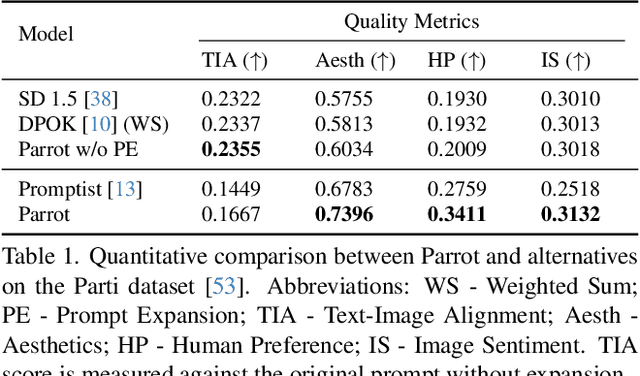

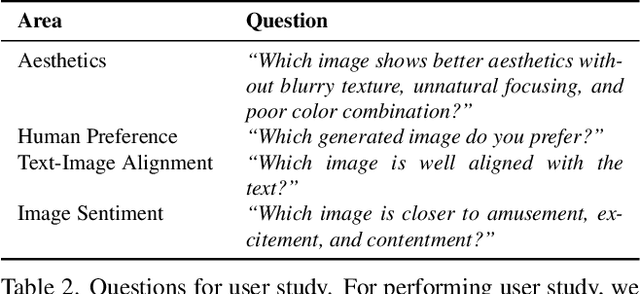
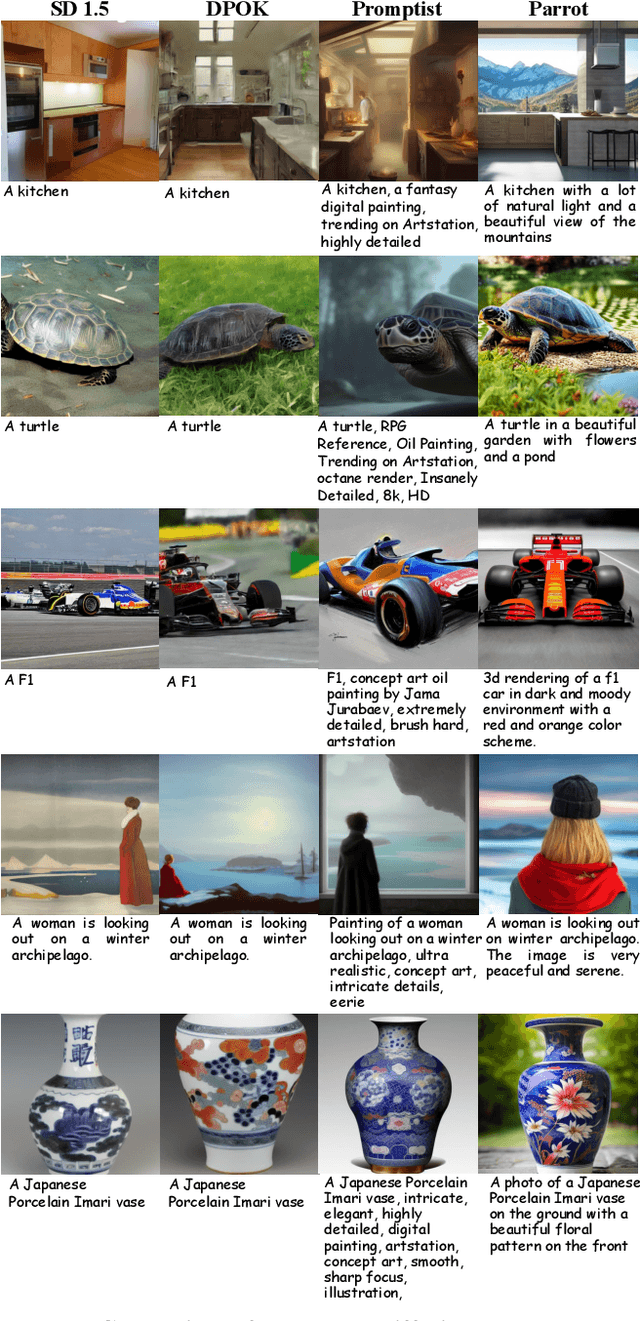
Abstract:Recent works demonstrate that using reinforcement learning (RL) with quality rewards can enhance the quality of generated images in text-to-image (T2I) generation. However, a simple aggregation of multiple rewards may cause over-optimization in certain metrics and degradation in others, and it is challenging to manually find the optimal weights. An effective strategy to jointly optimize multiple rewards in RL for T2I generation is highly desirable. This paper introduces Parrot, a novel multi-reward RL framework for T2I generation. Through the use of the batch-wise Pareto optimal selection, Parrot automatically identifies the optimal trade-off among different rewards during the RL optimization of the T2I generation. Additionally, Parrot employs a joint optimization approach for the T2I model and the prompt expansion network, facilitating the generation of quality-aware text prompts, thus further enhancing the final image quality. To counteract the potential catastrophic forgetting of the original user prompt due to prompt expansion, we introduce original prompt centered guidance at inference time, ensuring that the generated image remains faithful to the user input. Extensive experiments and a user study demonstrate that Parrot outperforms several baseline methods across various quality criteria, including aesthetics, human preference, image sentiment, and text-image alignment.
On-device Real-time Custom Hand Gesture Recognition
Sep 19, 2023



Abstract:Most existing hand gesture recognition (HGR) systems are limited to a predefined set of gestures. However, users and developers often want to recognize new, unseen gestures. This is challenging due to the vast diversity of all plausible hand shapes, e.g. it is impossible for developers to include all hand gestures in a predefined list. In this paper, we present a user-friendly framework that lets users easily customize and deploy their own gesture recognition pipeline. Our framework provides a pre-trained single-hand embedding model that can be fine-tuned for custom gesture recognition. Users can perform gestures in front of a webcam to collect a small amount of images per gesture. We also offer a low-code solution to train and deploy the custom gesture recognition model. This makes it easy for users with limited ML expertise to use our framework. We further provide a no-code web front-end for users without any ML expertise. This makes it even easier to build and test the end-to-end pipeline. The resulting custom HGR is then ready to be run on-device for real-time scenarios. This can be done by calling a simple function in our open-sourced model inference API, MediaPipe Tasks. This entire process only takes a few minutes.
Forward-Forward Training of an Optical Neural Network
May 30, 2023



Abstract:Neural networks (NN) have demonstrated remarkable capabilities in various tasks, but their computation-intensive nature demands faster and more energy-efficient hardware implementations. Optics-based platforms, using technologies such as silicon photonics and spatial light modulators, offer promising avenues for achieving this goal. However, training multiple trainable layers in tandem with these physical systems poses challenges, as they are difficult to fully characterize and describe with differentiable functions, hindering the use of error backpropagation algorithm. The recently introduced Forward-Forward Algorithm (FFA) eliminates the need for perfect characterization of the learning system and shows promise for efficient training with large numbers of programmable parameters. The FFA does not require backpropagating an error signal to update the weights, rather the weights are updated by only sending information in one direction. The local loss function for each set of trainable weights enables low-power analog hardware implementations without resorting to metaheuristic algorithms or reinforcement learning. In this paper, we present an experiment utilizing multimode nonlinear wave propagation in an optical fiber demonstrating the feasibility of the FFA approach using an optical system. The results show that incorporating optical transforms in multilayer NN architectures trained with the FFA, can lead to performance improvements, even with a relatively small number of trainable weights. The proposed method offers a new path to the challenge of training optical NNs and provides insights into leveraging physical transformations for enhancing NN performance.
MUSIQ: Multi-scale Image Quality Transformer
Aug 12, 2021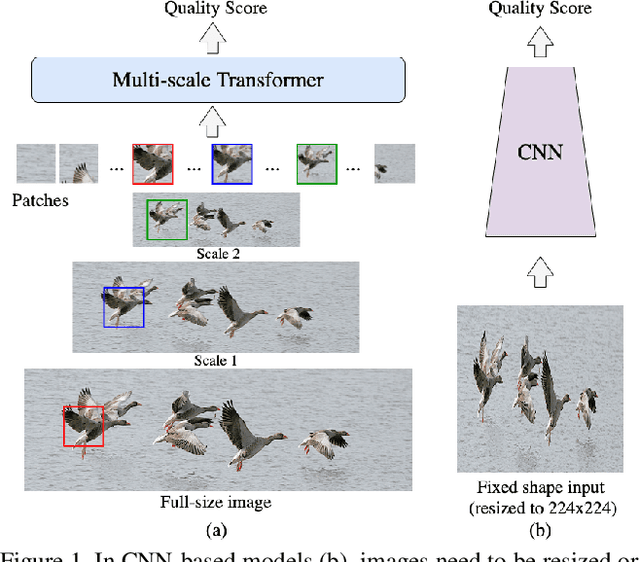
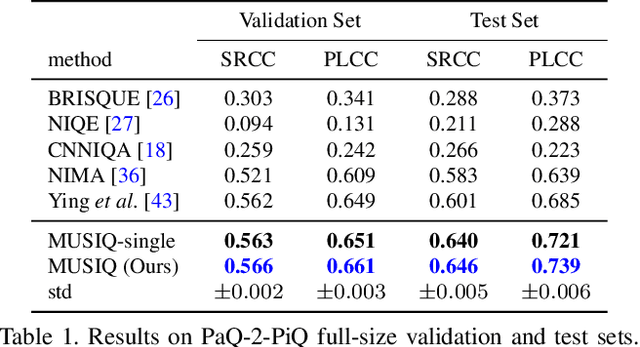
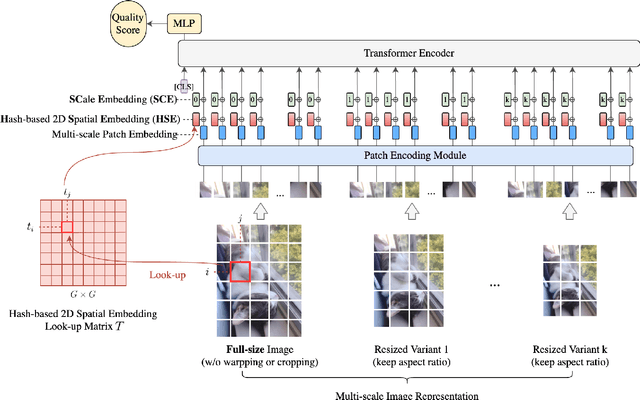
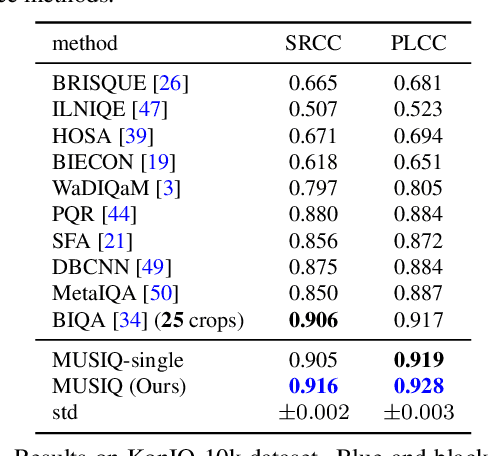
Abstract:Image quality assessment (IQA) is an important research topic for understanding and improving visual experience. The current state-of-the-art IQA methods are based on convolutional neural networks (CNNs). The performance of CNN-based models is often compromised by the fixed shape constraint in batch training. To accommodate this, the input images are usually resized and cropped to a fixed shape, causing image quality degradation. To address this, we design a multi-scale image quality Transformer (MUSIQ) to process native resolution images with varying sizes and aspect ratios. With a multi-scale image representation, our proposed method can capture image quality at different granularities. Furthermore, a novel hash-based 2D spatial embedding and a scale embedding is proposed to support the positional embedding in the multi-scale representation. Experimental results verify that our method can achieve state-of-the-art performance on multiple large scale IQA datasets such as PaQ-2-PiQ, SPAQ and KonIQ-10k.
Adversarially Adaptive Normalization for Single Domain Generalization
Jun 01, 2021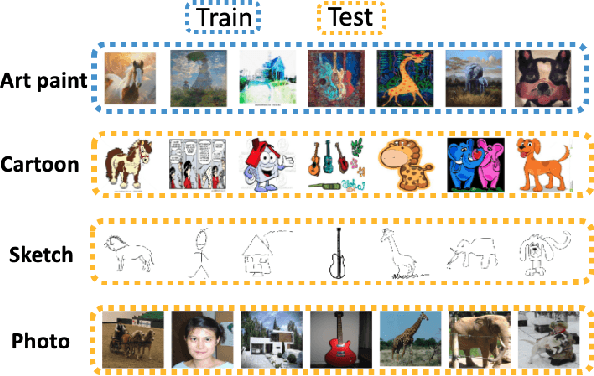
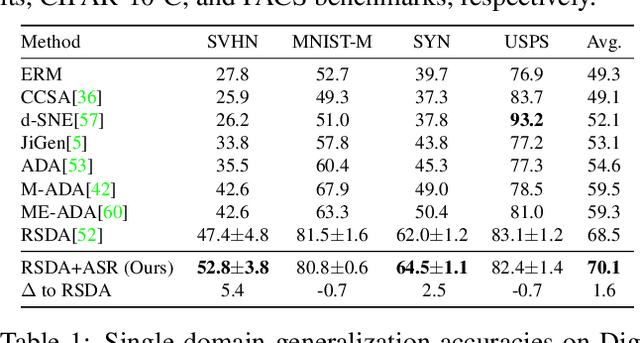
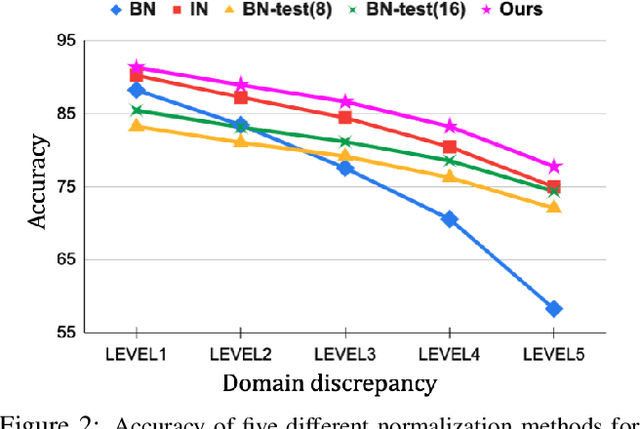
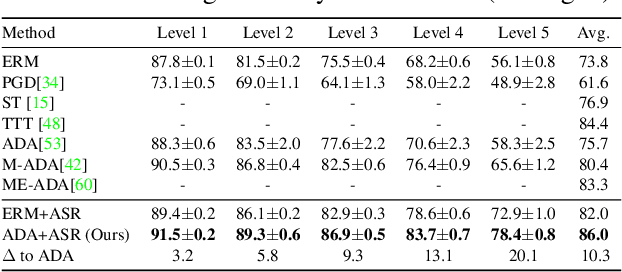
Abstract:Single domain generalization aims to learn a model that performs well on many unseen domains with only one domain data for training. Existing works focus on studying the adversarial domain augmentation (ADA) to improve the model's generalization capability. The impact on domain generalization of the statistics of normalization layers is still underinvestigated. In this paper, we propose a generic normalization approach, adaptive standardization and rescaling normalization (ASR-Norm), to complement the missing part in previous works. ASR-Norm learns both the standardization and rescaling statistics via neural networks. This new form of normalization can be viewed as a generic form of the traditional normalizations. When trained with ADA, the statistics in ASR-Norm are learned to be adaptive to the data coming from different domains, and hence improves the model generalization performance across domains, especially on the target domain with large discrepancy from the source domain. The experimental results show that ASR-Norm can bring consistent improvement to the state-of-the-art ADA approaches by 1.6%, 2.7%, and 6.3% averagely on the Digits, CIFAR-10-C, and PACS benchmarks, respectively. As a generic tool, the improvement introduced by ASR-Norm is agnostic to the choice of ADA methods.
Multi-path Neural Networks for On-device Multi-domain Visual Classification
Oct 10, 2020
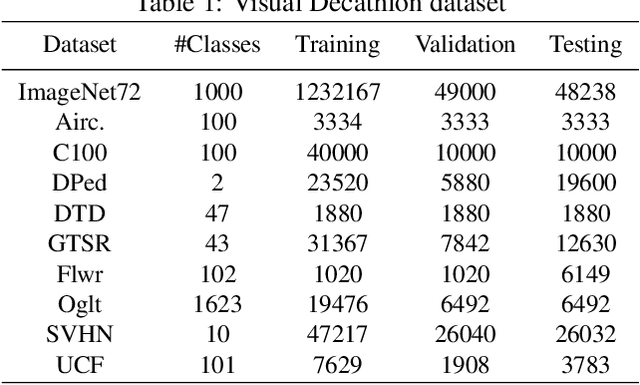
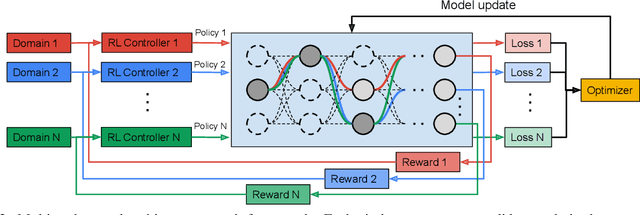

Abstract:Learning multiple domains/tasks with a single model is important for improving data efficiency and lowering inference cost for numerous vision tasks, especially on resource-constrained mobile devices. However, hand-crafting a multi-domain/task model can be both tedious and challenging. This paper proposes a novel approach to automatically learn a multi-path network for multi-domain visual classification on mobile devices. The proposed multi-path network is learned from neural architecture search by applying one reinforcement learning controller for each domain to select the best path in the super-network created from a MobileNetV3-like search space. An adaptive balanced domain prioritization algorithm is proposed to balance optimizing the joint model on multiple domains simultaneously. The determined multi-path model selectively shares parameters across domains in shared nodes while keeping domain-specific parameters within non-shared nodes in individual domain paths. This approach effectively reduces the total number of parameters and FLOPS, encouraging positive knowledge transfer while mitigating negative interference across domains. Extensive evaluations on the Visual Decathlon dataset demonstrate that the proposed multi-path model achieves state-of-the-art performance in terms of accuracy, model size, and FLOPS against other approaches using MobileNetV3-like architectures. Furthermore, the proposed method improves average accuracy over learning single-domain models individually, and reduces the total number of parameters and FLOPS by 78% and 32% respectively, compared to the approach that simply bundles single-domain models for multi-domain learning.
 Add to Chrome
Add to Chrome Add to Firefox
Add to Firefox Add to Edge
Add to Edge